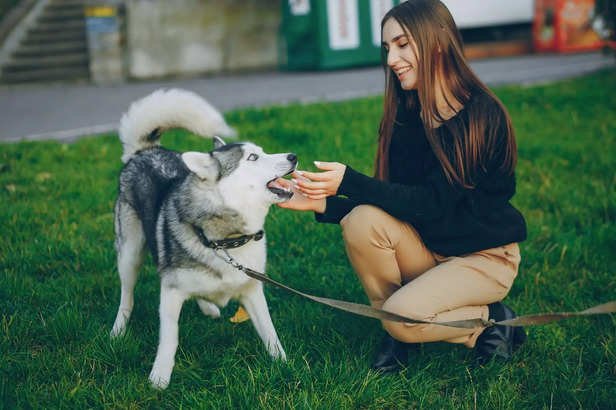Is Your Dog Sick? Warning Signs You Shouldn’t Ignore!
Ishan Banerjee | Freepik | Mar 31, 2025, 15:00 IST
Is Your Dog Sick_ Warning Signs You Shouldn’t Ignore!
Dogs can't tell us when they’re sick, but their bodies do. Subtle changes in behavior, appetite, or energy levels could mean something is wrong. Ignoring these signs might put your furry friend at risk! This guide breaks down the most common sickness signs in dogs and when to seek veterinary care—because knowing early can save a life.
Has your dog been acting strangely lately? Maybe they’re not as playful as usual, skipping meals, or sleeping more than normal. As pet owners, we often assume these changes are just mood swings or temporary fatigue. But what if they’re actually signs of illness? Dogs can’t tell us when they feel unwell, so it’s up to us to recognize early warning signs. Catching sickness early can mean the difference between a quick recovery and a serious health issue. Some symptoms, like vomiting or coughing, are obvious. Others, such as subtle behavior shifts or changes in eating habits, may go unnoticed until the condition worsens. This guide will help you identify key behavioral, physical, and hidden signs of illness in dogs. Understanding these symptoms early can help you take the right steps to keep your furry friend healthy and happy!
Common Behavioral Changes

Dogs communicate through their behavior, and sudden changes can signal underlying health problems. If your dog is acting differently, it may not just be a mood shift—it could be a sign of illness.
Unusual Lethargy or Fatigue
Is your usually energetic pup suddenly uninterested in playtime or long walks? If your dog seems excessively tired or sluggish, it could be dealing with pain, infections, or even more serious conditions like anemia or heart disease.
Loss of Interest in Play or Walks
If your dog is ignoring their favorite toy or avoiding walks, it might be experiencing discomfort, joint pain, or weakness. A sudden drop in enthusiasm for daily activities is a red flag.
Increased Irritability or Aggression
A normally friendly dog that suddenly growls, snaps, or avoids being touched might be in pain. Dogs tend to mask discomfort, but aggressive behavior can be their way of saying something is wrong.
Restlessness or Anxiety
Excessive pacing, whining, or difficulty settling down could indicate pain, digestive issues, or even neurological problems. Dogs with discomfort may struggle to find a comfortable position, which results in frequent shifting or pacing.
When to Worry?
If these behavioral changes last more than a day or two, or if they are accompanied by other symptoms (vomiting, loss of appetite, etc.), it’s best to consult a vet. Recognizing these subtle changes early can prevent more serious health complications!
Physical Symptoms You Can’t Ignore

Physical changes in your dog can be some of the most telling signs of illness. While occasional shifts in appetite or energy are normal, persistent or severe symptoms should never be ignored.
Changes in Appetite or Thirst
Has your dog suddenly stopped eating or started drinking excessive amounts of water? Loss of appetite could signal infections, dental pain, or even organ issues like kidney disease. On the other hand, increased thirst may be a sign of diabetes, hormonal imbalances, or kidney problems.
A single episode of vomiting or diarrhea isn’t necessarily alarming—dogs sometimes eat things they shouldn’t! However, frequent vomiting, blood in stool, or diarrhea lasting more than 24 hours could indicate infections, food poisoning, or gastrointestinal diseases.
Unexplained Weight Loss or Gain
If your dog is losing weight despite eating normally, it could be dealing with parasites, metabolic disorders, or even cancer. Sudden weight gain, especially without an increase in food intake, might point to hormonal imbalances like hypothyroidism or Cushing’s disease.
Bad Breath or Excessive Drooling
A dog’s breath might not always be minty fresh, but a foul odor could indicate dental infections, gum disease, or digestive issues. Excessive drooling, especially if sudden, may signal nausea, oral pain, or even poisoning.
When to See a Vet?
If these physical symptoms persist for more than a day or two, worsen over time, or appear alongside behavioral changes, a vet visit is essential. Early detection can prevent minor issues from turning into serious health conditions.
Hidden Health Signs
Some symptoms aren’t as obvious as vomiting or loss of appetite, but they can be just as serious. Subtle changes in your dog’s breathing, skin, or movement might be early warning signs of illness.
Changes in Breathing
Is your dog panting excessively, wheezing, or struggling to breathe? Labored breathing may indicate respiratory infections, heart disease, or allergies. If your dog is gasping for air or breathing heavily while at rest, seek immediate veterinary care.
Ear Scratching & Head Shaking
Frequent ear scratching or head tilting could be a sign of ear infections, allergies, or even ear mites. Left untreated, ear infections can cause pain, swelling, and hearing loss.
Skin and Coat Changes
A healthy dog should have a shiny coat and smooth skin. If you notice excessive scratching, bald patches, flaky skin, or redness, it could be due to allergies, parasites, or underlying health conditions.
Coughing & Sneezing
Occasional sneezing is normal, but persistent coughing or sneezing could indicate kennel cough, respiratory infections, or even heart problems. A honking cough, for example, is often associated with tracheal collapse in smaller breeds.
When to Be Concerned?
If your dog shows any of these hidden symptoms, monitor them closely. If symptoms persist for more than a couple of days, worsen rapidly, or interfere with your dog’s daily activities, consult a vet immediately. Recognizing these subtle signs early can make all the difference in your pet’s health.
When to See a Vet

While some sickness signs in dogs can be monitored at home, certain symptoms require urgent veterinary attention. Ignoring them could put your dog’s health—or even life—at risk.
Red Flag Symptoms That Need Immediate Attention:

Keeping your dog healthy isn’t just about treating sickness—it’s about preventing it. Regular checkups, proper nutrition, and early symptom recognition are key to a long, happy life for your furry friend.
Regular Vet Checkups
Routine vet visits (at least once a year) help catch diseases before they become serious. Vaccinations, dental checkups, and parasite control are essential for overall health.
Monitoring Diet & Exercise
A balanced diet and regular exercise keep your dog’s immune system strong. Avoid excessive treats, ensure proper hydration, and keep your pup active with daily walks and playtime.
No one knows your dog better than you. If they seem “off” in any way—be it appetite, energy, or behavior—it’s worth paying attention. Early detection can make all the difference!
If something feels wrong, don’t wait—trust your gut and call the vet! Your dog depends on you to keep them safe, healthy, and happy.
Discover expert advice and the latest tips on pet care, training, health, and more. Stay updated with all things pets at Times Pets!
Common Behavioral Changes

_Common Behavioral Changes
Dogs communicate through their behavior, and sudden changes can signal underlying health problems. If your dog is acting differently, it may not just be a mood shift—it could be a sign of illness.
Unusual Lethargy or Fatigue
Loss of Interest in Play or Walks
Increased Irritability or Aggression
Restlessness or Anxiety
When to Worry?
Physical Symptoms You Can’t Ignore

Physical Symptoms You Can’t Ignore
Physical changes in your dog can be some of the most telling signs of illness. While occasional shifts in appetite or energy are normal, persistent or severe symptoms should never be ignored.
Changes in Appetite or Thirst
Vomiting or Diarrhea
Unexplained Weight Loss or Gain
Bad Breath or Excessive Drooling
When to See a Vet?
Hidden Health Signs
Changes in Breathing
Ear Scratching & Head Shaking
Skin and Coat Changes
Coughing & Sneezing
When to Be Concerned?
When to See a Vet

When to See a Vet
While some sickness signs in dogs can be monitored at home, certain symptoms require urgent veterinary attention. Ignoring them could put your dog’s health—or even life—at risk.
Red Flag Symptoms That Need Immediate Attention:
- Seizures, collapse, or extreme weakness – These could indicate poisoning, neurological disorders, or severe infections.
- Continuous vomiting or diarrhea for more than 24 hours – Persistent stomach issues can lead to dehydration and signal serious conditions like parvovirus or pancreatitis.
- Difficulty breathing or severe pain – If your dog is gasping for air, has bluish gums, or is yelping in pain, it needs emergency care.
How to Document Symptoms for the Vet:
- Keep a log – Track changes in appetite, energy levels, bathroom habits, and any new symptoms.
- Capture videos – If your dog is coughing, limping, or having seizures, a short video can help the vet diagnose the issue more accurately.
- Note timing and duration – Details like when symptoms started and how long they last can provide critical clues.
Preventative Care & Final Thoughts

Preventative Care & Final Thoughts
Keeping your dog healthy isn’t just about treating sickness—it’s about preventing it. Regular checkups, proper nutrition, and early symptom recognition are key to a long, happy life for your furry friend.
Regular Vet Checkups
Monitoring Diet & Exercise
Staying Alert to Small Changes
If something feels wrong, don’t wait—trust your gut and call the vet! Your dog depends on you to keep them safe, healthy, and happy.
Discover expert advice and the latest tips on pet care, training, health, and more. Stay updated with all things pets at Times Pets!
Frequently Asked Questions (FAQs)
- How can you tell if a dog is unwell?
Look for changes in appetite, energy levels, behavior, or physical symptoms like vomiting and lethargy. - How do dogs act when they are sick?
Sick dogs may become withdrawn, irritable, restless, or show signs of weakness and discomfort. - How to cure a sick dog at home?
Provide rest, hydration, and a vet-approved diet, but consult a vet if symptoms persist or worsen. - How do I know if my sick dog is suffering?
Signs of suffering include persistent pain, difficulty breathing, extreme weakness, or loss of interest in food and activities.
